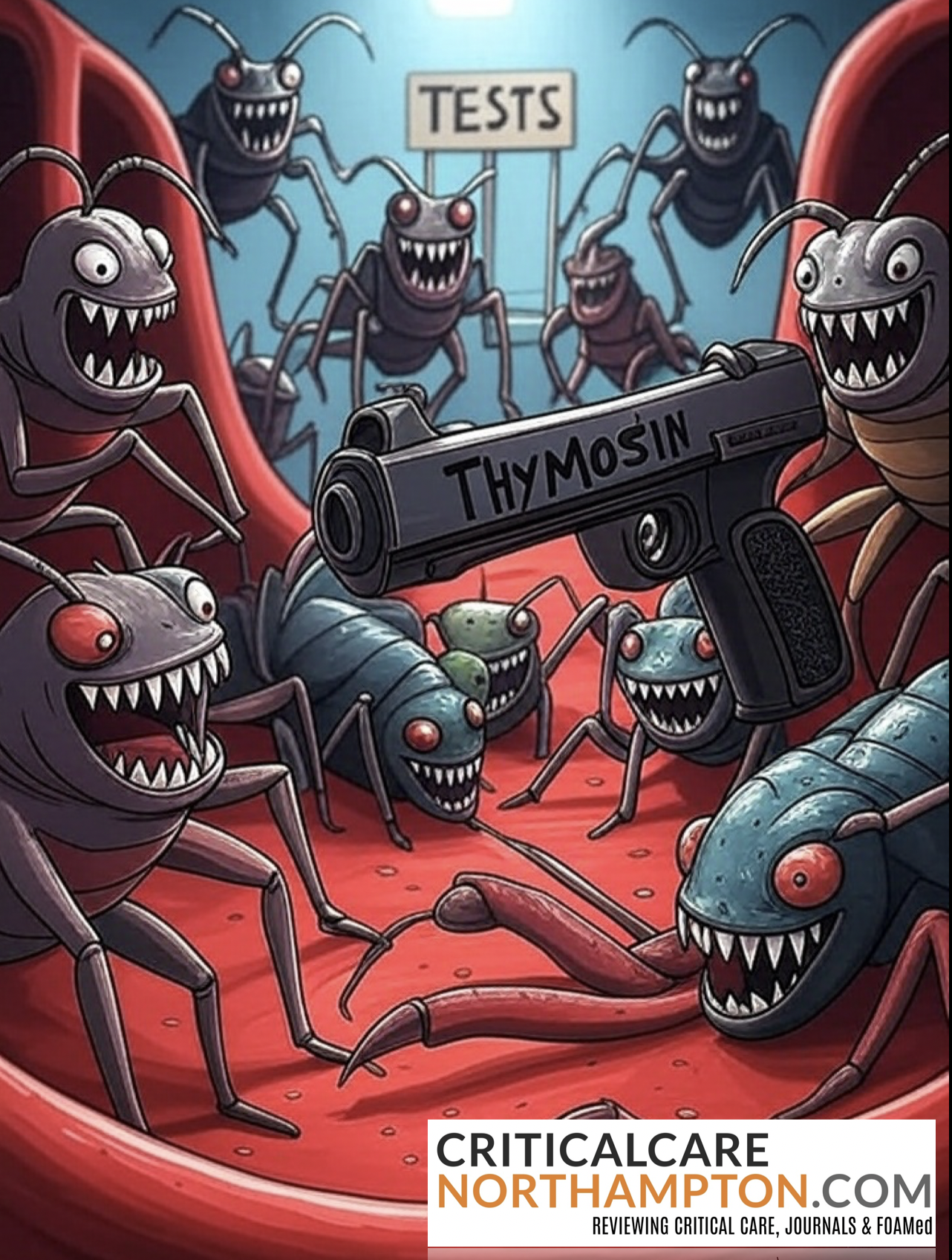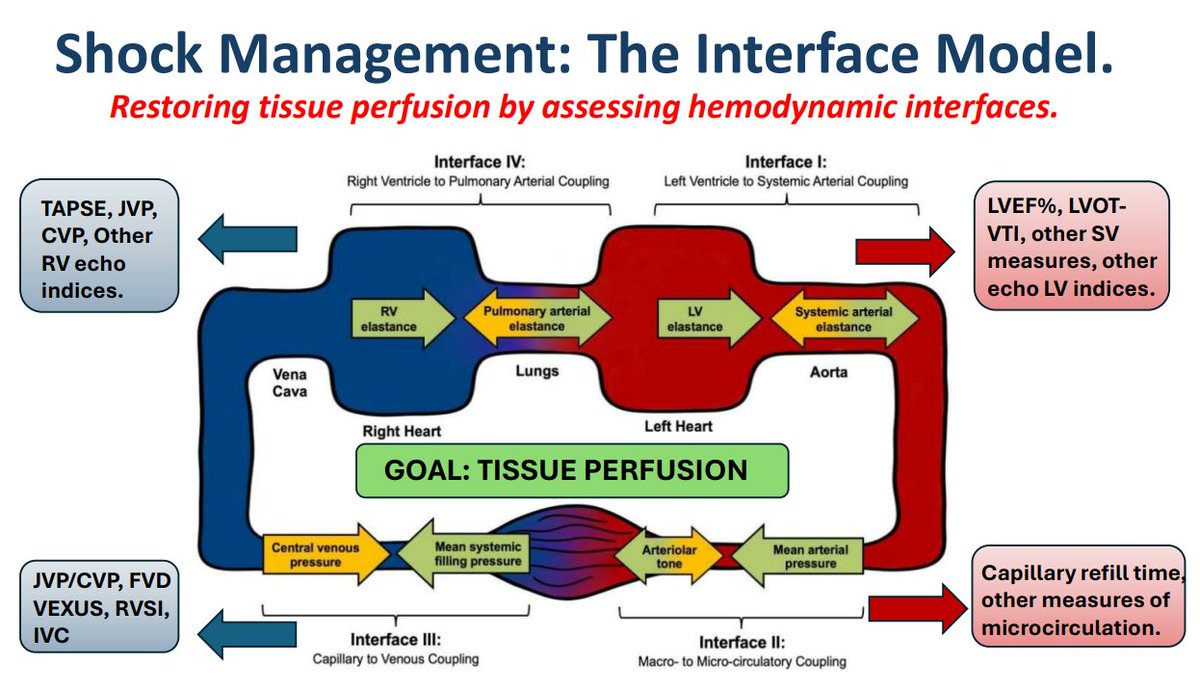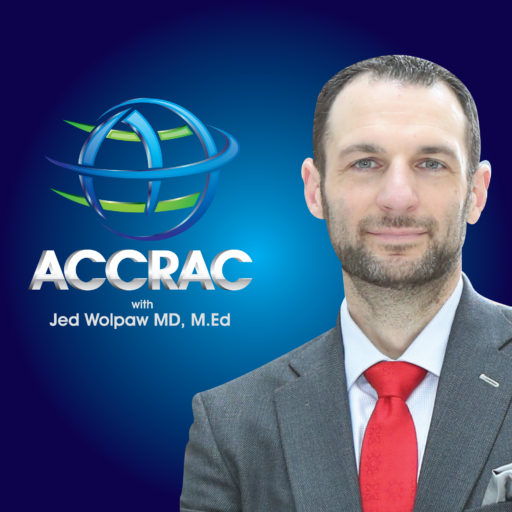What was it?
Multicentre, double-blind, placebo-controlled phase 3 trial (TESTS), evaluating whether thymosin α1, animmunomodulatory drug, reduces 28-day all-cause mortality in adults with sepsis, conducted across 22 centresin China from September 2016 to December 2020.
The Devil in the details!
- 1,106 adults (18–85 years) with sepsis per Sepsis-3 criteria, randomised 1:1 to thymosin α1 (n=552) or placebo (n=554), with 1,089 included in modified intention-to-treat analysis (thymosin α1: n=542, placebo: n=547).
- Subcut thymosin α1 (1.6 mg) vs placebo ‘lyophilised saline’ twice daily for 7 days (unless discontinued due to either discharge from ICU, death or withdrawal of consent)
- Primary outcome: 28-day all-cause mortality.
- Secondary outcomes: Sequential Organ Failure Assessment (SOFA) scores, immune markers (e.g., monocyte HLA-DR, lymphocyte count), ICU/hospital stay, and safety events.
- Secondary outcomes:
- Incidence of new onset infections within 28 days
- 28 day clearance rate of pathogenic microorganisms
- Duration of ICU and hospital stays
- Readmission to hospital within 28 days
- Changes in the SOFA score on day 7
- 90 day all-cause mortality
- Mechanical ventilation-free days within 28 days
- ICU-free days within 28 days
- Continuous renal replacement therapy-free days within 28 days
- Vasopressors-free days within 28 days, and score on the 36-item short form (SF-36) quality of life scale within 90 days
- Safety: Adverse events (AEs) and serious adverse events (SAEs) monitored for 90 days.
- Exploratory outcomes: change in monocyte human leucocyte antigen-DR, neutrophil to lymphocyte ratio, regulatory T cell percentage, and lymphocyte count at 7, 14, and 28 days, compared with baseline values obtained at screening
The results!
- All-cause mortality within 28 days
- Thymosin α1 group (23.4%)
- Placebo group (24.1%)
- No statistically significant difference (Hazard Ratio [HR] 0.97; 95% Confidence Interval [CI]: 0.76–1.24; P=0.82).
- 90-day all-cause mortality did not significantly differ between groups
- 31.0% in the thymosin α1 group
- 32.4% in the placebo group
- (HR 0.95; 95% CI: 0.77–1.17; P=0.61).
- In the thymosin α1 group, 28 day mortality was higher in participants younger than 60 years (1.67, 1.04 to 2.67); for participants aged 60 and older, the hazard ratio was 0.81 (0.61 to 1.09, P for interaction=0.01).
- Post hoc analysis suggested that thymosin α1 might not have increased 28 day mortality in participants younger than 60 (1.45, 0.89 to 2.36, P for interaction=0.04) after adjusting for organ support before randomisation.
- Participants with diabetes (0.58, 0.35 to 0.99, P for interaction=0.04), hypertension (0.71, 0.49 to 1.04, P for interaction=0.06) and coronary disease (0.47, 0.21 to 1.01, P for interaction=0.06) in the thymosin α1 group had a lower 28 day mortality compared to participants with same comorbidities in the placebo group.
- No statistically significant differences between thymosin α1 and placebo groups for these secondary clinical outcomes within 28 days: change in SOFA score, new onset infections, mechanical ventilation-free days, vasopressors-free days, continuous renal replacement therapy-free days.
- The thymosin α1 group had a significantly greater reduction in neutrophil to lymphocyte ratio compared to placebo.
- Over the 28-day follow-up, immune markers (HLA-DR, lymphocyte count, neutrophil to lymphocyte ratio) improved significantly in both groups, with no differences between thymosin α1 and placebo.
- Safety: AEs in 66.4% (thymosin α1) vs. 67.6% (placebo) (P=0.70); SAEs in 26.8% vs. 29.3% (P=0.38). Common AEs: anaemia (10.7%), fever (9.6%), abdominal distension (5.4%). No unexpected SAEs related to thymosin α1.
They concluded…
The authors concluded that thymosin α1 did not reduce 28-day mortality in adults with sepsis but showed a good safety profile. However, thymosin α1 might have beneficial effects in patients aged 60 years and older and those with chronic conditions.
Gripe point summary!
- No mortality benefit despite prior smaller studies suggesting a 41% relative reduction (RR 0.59, 95% CI 0.45–0.77).
- Subgroup findings (age, diabetes) hypothesis-generating but not definitive due to multiple testing and lack of Bonferroni correction in some analyses.
- Heterogeneous sepsis population may mask benefits in specific subgroups.
- Short treatment duration (7 days) may be insufficient for immunomodulatory effects.
- Limited generalizability: Conducted only in China, potentially reflecting local practices.
- Data errors from COVID-19 disruptions required post hoc corrections, raising concerns about data integrity.
- Immune marker analysis (e.g., mHLA-DR) limited by infrequent use of flow cytometry in multicentre settings.
- No cost-effectiveness analysis for a resource-intensive therapy.
Our summary
In this large, well-designed trial, thymosin α1 failed to reduce 28-day mortality in sepsis (HR 0.99, P=0.93), despite a good safety profile (AEs: 66.4% vs. 67.6%, P=0.70). Subgroup signals in older patients and those with diabetes suggest possible targeted benefits, but the lack of overall efficacy challenges prior smaller studies. Larger, global trials focusing on specific subgroups and longer treatment durations are needed to clarify thymosin α1’s role in sepsis management.
Who’s worked on this before?
Ulinastatin- and thymosin α1-based immunomodulatory strategy for sepsis: A meta-analysis
Assessment of the immune function of aged patients before and after immunotherapy in severe sepsis
Further gripes!
- Subgroup analyses (e.g., age, diabetes) were underpowered and prone to type I errors due to multiple comparisons without consistent adjustment.
- Sepsis heterogeneity (e.g., infection source, severity) not fully addressed, potentially diluting treatment effects in specific phenotypes.
- COVID-19-related data errors (9/1,106 patients lost to follow-up) raise concerns about trial oversight during disruptions.
- Lack of detailed reporting on co-interventions (e.g., antibiotics, steroids) that could confound outcomes.
- Immune marker assessments (mHLA-DR, lymphocyte counts) were inconsistent across centres, limiting their interpretability.
- Exclusion of immunocompromised patients (e.g., organ transplant recipients) due to thymosin α1’s contraindication narrows applicability.
- Possible deviations in treatment administration or follow-up across multiple centres could affect results.
- 17 participants (10 thymosin α1, 7 placebo) excluded because they never received study drug and withdrew consent, small number but slightly more in treatment group.
- No long-term outcomes (beyond 90 days) to assess sustained benefits or delayed harms.
- Single-country setting limits generalizability to diverse healthcare systems with varying ICU practices.
- High baseline immune dysregulation in both groups may have masked thymosin α1’s immunomodulatory effects.
- No exploration of dose escalation or extended treatment duration, despite prior studies suggesting potential benefits.
Written by Dr Rawan Nasr
Peer reviewed by JW










